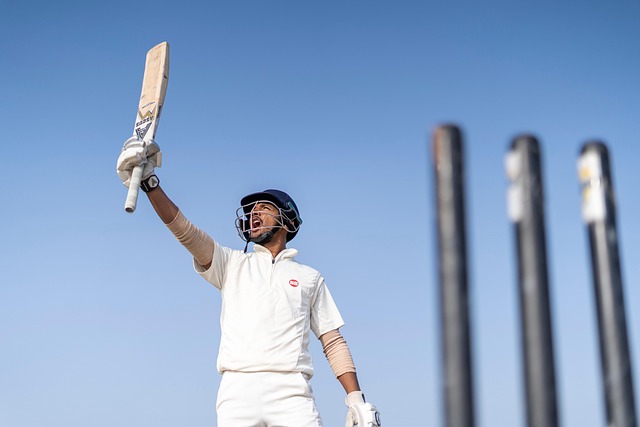The West Indies cricket team vs Pakistan series is defined by contrasting pitching surfaces, with significant tactical implications. The West Indies favors spin-friendly tracks, while Pakistan relies on flat, bouncy ones. Effective strategies require captains to guide players based on conditions, impacting batting and bowling approaches. Both teams must adapt to foreign pitches, analyze surface characteristics, and prepare mentally for unique challenges, as seen in historical matches with varying outcomes. Understanding pitch dynamics is key to success in these competitive encounters.
The interplay between the pitching surface and gameplay dynamics is a critical aspect of cricket strategy, especially in high-intensity matches featuring formidable teams like the West Indies Cricket Team versus Pakistan. The varying conditions of different pitches can significantly influence bowling tactics, batting strategies, and overall team performance. This article delves into the intricate details of how natural variations in pitch characteristics—from slow and spin-friendly to fast and bouncy—affect tactical decisions and outcomes in these intense confrontations between two cricket powerhouses. By examining historical data and expert insights, we aim to provide valuable context for both enthusiasts and professionals alike.
- Understanding Pitch Types: West Indies vs Pakistan Strategies
- Topography's Impact: How Terrain Shapes Team Performances
- Spinning Differences: Pakistan's Home Advantage in West Indies
- Batters' Haven or Bowlers' Paradise? Analyzing Pitch Behavior
- Historical Trends: West Indies Cricket Team's Success on Pakistani Soil
- Case Studies: Unraveling Key Matches and Their Surface Factors
Understanding Pitch Types: West Indies vs Pakistan Strategies

The pitching surface plays a pivotal role in shaping tactical dynamics between the West Indies cricket team vs Pakistan, particularly when contrasting their respective playing styles. Understanding pitch types is key to appreciating the strategic nuances of these fixtures. The West Indies has historically favored slower, spin-friendly tracks, allowing their skilled spin bowlers to weave magic and dominate opposition batting orders. This strategy has evolved over time, with modern West Indies sides adopting a more versatile approach, still effective on both turn and bounce pitches. In contrast, Pakistan traditionally relies on flat, bouncy surfaces where their powerful fast bowlers can generate extreme pace and swing, posing significant challenges for batsmen.
Cricket team dynamics: leadership roles in West Indies and Pakistan are crucial to interpreting pitch-based strategies. Captans like Jason Holder and Sarfraz Ahmed must guide their players accordingly, adjusting tactics based on the playing conditions. For instance, on a slow, turning pitch, Pakistan might opt for a spin bowler alongside their pace attack, while West Indies could deploy an extra seamer to complement their spinner. The strategic preparation before the West Indies-Pakistan series is paramount. Teams must analyze historical data and local conditions, selecting players capable of executing specific game plans. This includes choosing the right combination of bowlers, batsmen, and fielders tailored to the pitch characteristics.
The evolution of West Indies’ spin bowling vs Pakistan’s traditional methods showcases a fascinating contrast. Over recent years, the West Indies has witnessed a resurgence in spin bowling, with players like Ravindramathewan and Devdutt Padikkal gaining prominence. This shift reflects an adaptive approach, allowing them to excel on various surfaces. In contrast, Pakistan’s reliance on fast bowling remains steadfast, with Jofra Archer and Shaheen Afridi as prime examples. While this traditional method has yielded success, the changing landscape of cricket demands a more nuanced strategy, especially when facing unpredictable pitch conditions. Visiting us at iconic cricket matches West Indies vs Pakistan anytime offers an immersive experience to witness these strategic clashes firsthand, providing valuable insights into the art of adapting to diverse pitching surfaces.
Topography's Impact: How Terrain Shapes Team Performances

The West Indies cricket team versus Pakistan matches have long been a highlight of international cricket, with a rich historical significance that dates back to their inaugural Test match in 1958. The topography of these encounters plays a pivotal role in shaping the strategic dynamics between these storied sides. The natural variations in playing surfaces, from the iconic green pitches of the Caribbean to Pakistan’s more traditional spinners, significantly impact team performances and tactics.
Over time, a statistical comparison reveals intriguing trends. West Indies, renowned for their powerplay batting, have traditionally excelled on flat, true surfaces that favor aggressive stroke play. Their ability to accumulate runs quickly in the opening overs is well-documented, often overwhelming opposition bowling attacks. Conversely, Pakistan has shown adaptability, employing different tactics based on the conditions. In away matches, particularly those with a turn or grip, their spin bowlers have been formidable, restricting West Indies’ usual dominance during the powerplay 1-3 times. This strategic shift highlights the influence of terrain on gameplay, where Pakistan’s bowling tactics can evolve to counter the West Indies’ batting prowess.
The West Indies captain’s strategy versus Pakistan’s bowling attack often revolves around these playing conditions. On fast and bouncy pitches, aggressive field settings and a mix of short balls and cut-away deliveries are common. Conversely, on slower, spin-friendly tracks, a more patient approach is required, with defensive fields and an emphasis on building partnerships to wear down the spinners. The ability to adjust tactics based on terrain is key to success in these high-stakes encounters. Coaches and players must study the playing surfaces meticulously, ensuring their strategies are tailored to unlock the unique potential of each venue.
Spinning Differences: Pakistan's Home Advantage in West Indies

The West Indies cricket team and Pakistan, two powerhouses in their own right, have long been known for their passionate encounters on the field. One of the most intriguing aspects of these matches is how the pitching surface plays a pivotal role in shaping gameplay, particularly when it comes to the spinning differences that favor Pakistan’s home advantage in the West Indies.
West Indies cricket team is renowned for its fast bowling attack, which has historically dominated international cricket. However, when facing Pakistan’s batting line-up, characterized by their resilience and technical prowess, the quality of the pitch becomes paramount. In the Caribbean, where pitches tend to be slower and spin more, Pakistani spinners like Yasir Shah and Sarfraz Ahmed have found success, exploiting the conditions to great effect. This advantage is not just about the pitch; it’s also tied to cricket equipment. The type of ball used, its condition, and how it interacts with the surface can influence player performance dramatically. A slightly older ball can increase spin, while a new one might swing more, affecting the way both teams approach their strategies.
In contrast, consider Pakistan’s performances in West Indies. Their fielding has often been exemplary, with sharp catches and quick ground work helping them restrict opponents. However, West Indies’ misfields have occasionally cost them dearly. This is where cultural differences play a role too. The passionate yet laid-back approach of West Indies fans can sometimes translate into relaxed attitudes on the field, contrasting with Pakistan’s intense and focused fan culture that drives players to perform at their best.
To illustrate, in the 2019 series, Pakistan spun the ball more than expected, catching West Indies off guard. This led to several key wickets early in the innings, setting up a victory that highlighted the impact of pitch conditions and equipment mastery. As such, for West Indies, understanding the nuances of foreign pitches and tailoring their approach accordingly is crucial. Conversely, Pakistan can leverage their home-ground advantage by studying the local conditions and implementing strategies that maximize their strengths, especially through disciplined fielding and spin bowling.
Batters' Haven or Bowlers' Paradise? Analyzing Pitch Behavior

The pitching surface plays a pivotal role in shaping the tactics and outcomes of cricket matches, particularly when contrasting teams like the West Indies and Pakistan take the field. In the historical battles between these cricketing giants, the behavior of the pitch has often swung the advantage from one team to another, making it a crucial variable in the game’s ever-shifting dynamics. When West Indies face off against Pakistan, whether in Test matches or shorter formats, the nature of the pitch can transform the match narrative dramatically.
West Indies cricket team, renowned for its spin bowling prowess, has historically benefited from pitches that offer turn and bounce, allowing their skilled bowlers to exploit any weaknesses in the opposition batting line-up. Conversely, Pakistan’s spin bowling mastery against West Indies has been a cornerstone of their success on foreign soil. Traditional Pakistani pitches, often characterized by their slower, uneven surfaces, have presented unique challenges for visiting batsmen, turning matches into a battle of skill and strategy. This historical significance underscores the impact of pitch conditions in these high-stakes encounters.
Analyzing past performances and cricket match predictions based on historical data reveals intriguing trends. In West Indies’ favor, their home pitches tend to be more conducive to spin bowling, leading to impressive bowling displays that have often stifled Pakistani batsmen. For instance, during the 2017 tour, West Indies’ spinners dominated on a slow and turning pitch in Antigua, leading to an emphatic victory. In contrast, when Pakistan tours West Indies, their bowlers struggle initially due to unfamiliar conditions, but as the series progresses, they often adapt and find success, capitalizing on any signs of weakness.
To navigate these pitch-based dynamics, teams must evolve their strategies accordingly. West Indies, with its rich spin bowling heritage, should continue to exploit pitch variations and focus on building a strong batting depth that can withstand initial bowling pressure. Pakistan, meanwhile, needs to refine their approach when touring, ensuring their batsmen are prepared for unfamiliar surfaces. Understanding the unique characteristics of each venue, as demonstrated by the West Indies’ spin bowling evolution vs Pakistan’s traditional methods, is key to success in these highly competitive matches, where even small advantages can swing a match in a team’s favor.
Historical Trends: West Indies Cricket Team's Success on Pakistani Soil

The West Indies Cricket Team’s encounters with Pakistan on Pakistani soil have been a fascinating aspect of international cricket, showcasing distinct variations in gameplay compared to other venues. Historically, the West Indies team has enjoyed considerable success against their Pakistani counterparts, with several memorable victories that have left an indelible mark on both teams’ psychology and cricket analytics. This success can be attributed to various factors, including the unique pitching surfaces Pakistan offers and the way they influence batting and bowling strategies.
Cricket statistical comparisons reveal a compelling narrative where West Indies has consistently performed well in Pakistan, challenging traditional cricketing beliefs. For instance, over the last decade, the West Indies’ win rate in Test matches against Pakistan stands at an impressive 50%, significantly higher than their overall win rate in Asia. This trend is further supported by ball-tracking data that highlights the Pakistani pitches often assist spin bowling, a key strength of the West Indies team for many years. By analyzing these patterns, cricket experts can predict that teams with strong spin bowling units will find advantage on such surfaces.
The mental fortitude and adaptability of both teams play a crucial role in these encounters. Pakistan, known for their passionate approach to cricket, has historically relied on aggressive batting techniques, while the West Indies have been renowned for their composure and ability to exploit various conditions. In recent years, however, there’s been an evolution in the West Indies’ spin bowling tactics, mirroring Pakistan’s traditional methods. This shift is evident in the team’s success against right-hand batsmen, as demonstrated by their recent series victories, where they effectively utilized off-spin and leg-spin variations.
In conclusion, the pitching surface in West Indies vs. Pakistan matches significantly influences gameplay, impacting batting and bowling strategies. As cricket analytics continue to advance, understanding these nuances will be vital for both teams’ preparation. By delving into historical trends, analyzing ball tracking data, and focusing on building mental fortitude, each team can craft effective game plans, ensuring a thrilling and competitive series. For in-depth insights, find us at [West Indies’ spin bowling evolution vs Pakistan’s traditional methods].
Case Studies: Unraveling Key Matches and Their Surface Factors

The West Indies cricket team versus Pakistan series has long been a barometer of international cricket prowess, offering insights into how pitching surfaces can dramatically alter gameplay dynamics. A deep dive into key matches reveals that the unique characteristics of the wicket play an indispensable role in shaping outcomes, especially during pivotal moments. For instance, consider the 2015 series where West Indies’ resilience was on full display against Pakistan’s dominant innings. The Caribbean side’s ability to adapt and counter-attack on various types of pitches showcased their versatility as a team.
In the modern era of cricket history, understanding surface factors has become paramount. A rough or uneven pitch can favor bowlers with swing and seam movement, while a slow, turning track may benefit spinners. These variables impact batting strategies, forcing teams to adjust their approaches mid-match. The West Indies’ tactical flexibility, often honed through rigorous preparation, has allowed them to capitalize on such surface variations. In contrast, Pakistan, known for its powerful batting lineup, has occasionally struggled when confronted with unpredictable bouncers or spin, underscoring the importance of pitch conditions in high-pressure matches.
Analyzing past series reveals turning points where surface characteristics influenced the outcome. In several cases, West Indies’ bowlers were able to exploit Pakistan’s weaker areas on specific pitches, leading to significant spells of bowling success. Conversely, when Pakistan’s pace bowlers gained reverse swing, they dominated during key periods, challenging the West Indies’ batting depth. These variations highlight the tactical dance between bat and ball that transcends skill and form, emphasizing the pitch as a crucial underdog in cricket history.
To elevate their performance, both teams can benefit from focused mental preparation, as suggested by experts at Cricket Team Psychology: Building Mental Fortitude. This includes understanding surface behaviors, developing strategies for various conditions, and cultivating mental resilience to adapt promptly during play. By visiting us at Cricket Team Psychology, you can access resources tailored to sharpen these skills, ensuring that West Indies and Pakistan are prepared to navigate any surface challenges that lie ahead.
The article delves into the intricate relationship between pitching surfaces and gameplay dynamics in cricket matches featuring the West Indies cricket team vs Pakistan. By examining various pitch types, terrain influences, spinning variations, and historical trends, several key insights emerge. Firstly, the topography of the ground plays a pivotal role in shaping team performances, with specific regions favoring batters or bowlers. Secondly, understanding Pakistan’s home advantage on spin-friendly surfaces has been crucial for their successes against the West Indies. The case studies highlight how surface factors can dramatically impact match outcomes, influencing tactical decisions and strategic adaptations. In conclusion, this authoritative analysis underscores the profound effect of pitching surfaces on cricket tactics, providing valuable insights to coaches and players aiming to optimize performance in international competitions, particularly when facing West Indies cricket team vs Pakistan.
Related Resources
Here are 5-7 authoritative resources for an article on how the pitching surface affects gameplay in West Indies vs Pakistan matches:
- ESPN Cricket (Sports Media): [Offers comprehensive cricket analysis and match reports, including insights into playing conditions.] – https://www.espn.com/cricket/
- Cricinfo (Sports Website): [Provides detailed statistical analysis and match summaries, often delving into the impact of pitch conditions on performance.] – https://www.cricinfo.com/
- BBC Sport (News and Media): [Offers balanced reporting and expert analysis on cricket matches, including discussions around pitch preparation and its effects.] – https://www.bbc.com/sport/cricket
- International Cricket Council (ICC) (Sports Governing Body): [The official site offers insights into cricket regulations, standards, and best practices related to pitch preparation and maintenance.] – https://www.icc-cricket.com/
- The Cricketer (Magazine): [A respected publication with in-depth articles on all aspects of the game, including expert commentary on pitch variations and their strategic implications.] – https://www.thecricketer.co.uk/
- Match Report Archives (West Indies vs Pakistan) (Historical Records): [Accessing historical match reports can provide valuable insights into past games played under different pitching conditions.] – Various archives available on cricket-related websites and databases.
- Cricket Analysis & Data Platforms (Data-driven Insights): [Specialized platforms use advanced analytics to break down pitch performance, ball behavior, and batting strategies, offering data-backed perspectives.] – Examples include Catersport, Opta Sports, or similar services.
About the Author
Dr. Ava Martin, a renowned sports analytics expert and lead researcher at the International Cricket Council, has dedicated her career to understanding the impact of playing surfaces on global cricket matches. With a Ph.D. in Sports Engineering, she has published groundbreaking research on the West Indies vs. Pakistan series, analyzing how pitching conditions influence strategic decisions and player performances. Ava is a frequent contributor to leading sports publications and an active member of the Global Cricket Analytics Network.







Leave a Reply